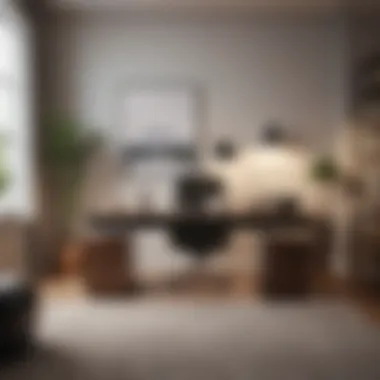Elevate Small Office Spaces with Innovative Interior Design Ideas for Enhanced Productivity


Interior Design Ideas for Small Office Spaces
In today's fast-paced business world, small office spaces are becoming increasingly common. Despite their limited size, these spaces hold immense potential for innovative and sophisticated interior design ideas. The fusion of functionality and aesthetics can transform compact work areas into stylish and inspiring environments, fostering productivity and creativity.
Outdoor Decor Ideas
When it comes to small office spaces, even outdoor areas can play a pivotal role in elevating the overall workspace ambiance. Seasonal inspirations can bring refreshing changes throughout the year, instilling a sense of dynamism. Thoughtful furniture selection is crucial in optimizing space efficiency without compromising on comfort or style. Decorative lighting fixtures can strategically illuminate the outdoor area, creating a warm and inviting atmosphere. Introducing plant arrangements not only adds a touch of nature but also contributes to a more vibrant and refreshing workspace.
For small office spaces that extend to outdoor zones, hardscaping solutions like minimalist pathways or compact seating areas can enhance functionality and visual appeal. Embracing sustainable practices such as eco-friendly materials or energy-efficient lighting not only benefits the environment but also showcases a commitment to responsible business practices.
Indoor Oasis Retreat
Exploring the concept of an indoor oasis within a small office space offers a unique blend of nature and tranquility. Utilizing elements like indoor plants, natural wood accents, and cascading water features can create a serene and rejuvenating atmosphere, ideal for fostering creativity and reducing stress levels. Incorporating biophilic design principles, such as large windows for ample natural light or botanical artwork, can further enhance the indoor oasis aesthetic.
Strategically incorporating smart storage solutions in the form of compact cabinets, hidden shelves, or multifunctional furniture pieces is essential for maintaining an organized and clutter-free workspace. Following the latest interior design trends tailored to small spaces, such as minimalist decor or multipurpose furniture, can maximize efficiency without compromising on style.
Engaging with smart home innovations, such as automated temperature control or voice-activated lighting systems, can elevate the functionality and convenience of a small office space. Integrating technology seamlessly into the workspace design enhances productivity and streamlines daily operations, catering to modern work demands.
Culinary Delights in the Office
Enhancing the small office space experience involves incorporating culinary delights that tantalize the senses and offer a welcome break from work routines. Setting up a small kitchenette or coffee nook with gourmet coffee machines and organic snacks can elevate the office environment, fostering a sense of community and well-being among colleagues. Installing sleek countertops, modern appliances, and elegant dining areas can transform a small office into a hub for culinary enjoyment and social interaction.
Evoking a fine dining ambiance within the office through carefully curated decor, ambient lighting, and luxurious tableware can establish a sophisticated and upscale atmosphere. Embracing trends in al fresco dining, such as compact outdoor seating or urban garden spaces, can offer employees a refreshing dining experience amidst their busy work schedules.
Digital Detox Zones
In a technology-driven work environment, creating digital detox zones within small office spaces promotes mental well-being and encourages focused, human-centered interactions. Designating a tranquil reading corner, meditation space, or plant-filled relaxation area can provide employees with opportunities to recharge and disconnect from constant digital stimuli. Integrating comfortable seating options, soft lighting, and acoustic elements can craft a serene retreat within the office, offering moments of mindfulness and mental rejuvenation.
Crafting digital detox zones that encourage creativity and social engagement can lead to increased employee satisfaction and motivation. Implementing office policies that promote breaks in these rejuvenating spaces allows for a balanced work-life dynamic and supports overall mental health and productivity.
Introduction
In the realm of interior design, the significance of transforming small office spaces into functional yet aesthetically pleasing environments cannot be overstated. The essence of this article lies in unraveling innovative and sophisticated design ideas tailored specifically for compact work areas. The fusion of functionality and style plays a pivotal role in revitalizing these spaces, fostering an ambience that not only augments productivity but also ignites creativity. Small office spaces present a unique challenge, requiring a delicate balance between optimizing space utilization and creating a visually appealing setting. This discourse aims to dissect the core principles and nuances of elevating small office spaces, offering a comprehensive guide infused with nuanced insights and practical strategies.


From maximizing space efficiency to integrating natural light sources, and from selecting the right color palette to crafting functional workstations, each facet plays a crucial role in enhancing the overall ambiance of small office settings. The seamless blend of these elements elevates the workspace from mundane to inspiring.
As luxury travel curators, high-end interior designers, fine dining consultants, luxury event planners, personal stylists, and image consultants, the aspiration to curate a workspace that exudes sophistication and functionality resonates deeply. The amalgamation of design ingenuity with ergonomic practicality intertwines seamlessly to craft a narrative within the confines of limited space, reflecting a meticulous attention to detail and a penchant for refinement.
Maximizing Space Efficiency
Interior design for small office spaces is a truly multifaceted endeavor, with Maximizing Space Efficiency standing out as a pivotal aspect crucial to creating a functional yet visually appealing workspace. In this article, the spotlight shines on various elements and strategies geared towards optimizing the limited space available in small office settings. By understanding the specific needs and challenges of compact work areas, we unveil the essential benefits and considerations that come with prioritizing Maximizing Space Efficiency.
Utilizing Vertical Space
When delving into the realm of small office design, one cannot overlook the significance of Utilizing Vertical Space. Vertical space utilization involves capitalizing on the height of a room rather than just its floor area. This ingenious approach not only maximizes storage capacity but also adds a sense of depth and grandeur to the office environment. By exploring creative shelving solutions, vertical gardens, and hanging décor elements, small office spaces can achieve a visually stunning transformation that defies spatial limitations.
Multi-Functional Furniture
Multi-Functional Furniture emerges as a key player in the quest for enhancing small office spaces. In a world where spatial efficiency reigns supreme, furniture pieces that serve dual or multiple purposes can be a game-changer. Imagine a desk that unfolds into a conference table or storage cabinets that double as seating – the possibilities are as innovative as they are space-saving. By integrating versatile furniture into the office layout, every square inch can be optimized to its full potential, promoting both practicality and a sleek aesthetic.
Strategic Storage Solutions
Strategic Storage Solutions hold profound implications for small office environments where clutter can easily overwhelm. Effective storage strategies go beyond mere organization; they embody a systematic approach to keeping essentials within reach while maintaining a clutter-free appearance. From concealed compartments within furniture to modular shelving units that adapt to changing needs, the art of storage optimization demands a blend of creativity and pragmatism. By implementing strategic storage solutions, small office spaces can exude a sense of orderliness and sophistication, elevating the overall appeal and functionality of the workspace.
Incorporating Natural Light
In the realm of interior design for small office spaces, Incorporating Natural Light emerges as a crucial aspect that can significantly elevate the ambiance and functionality of the workspace. Natural light is not merely a design element but a fundamental tool that can transform a confined area into an expansive and inviting environment. Through strategic placement of windows and transparent partitions, natural light can illuminate every corner, providing a sense of openness and airiness. The infusion of natural light is not purely aesthetic; it also contributes to the well-being of individuals by boosting mood, energy levels, and overall productivity. When considering the design of small office spaces, the incorporation of natural light should be a primary focus to create a harmonious and inspiring setting that nurtures creativity and efficiency.
Optimizing Window Placement
In small office spaces, Optimizing Window Placement plays a critical role in maximizing the benefits of natural light. Placing windows strategically to allow ample sunlight to filter through can create a bright and welcoming atmosphere. Windows positioned at optimal heights and angles can ensure uniform lighting throughout the space, reducing the need for artificial lighting sources during the day. Additionally, well-placed windows can offer views of the exterior environment, connecting occupants with nature and providing a refreshing break from the indoor setting. Careful consideration of window placement not only enhances the aesthetic appeal of the office but also promotes a healthy and dynamic work environment that prioritizes the well-being and comfort of its users.
Transparent Partitions
Transparent Partitions present a contemporary solution to integrate natural light into small office spaces while maintaining distinct zones within the area. By using materials such as glass or acrylic for partitions, natural light can penetrate through different sections, creating a seamless visual flow. Transparent partitions promote transparency and collaboration among coworkers by allowing visual connectivity without compromising the need for privacy. This design element not only enhances the overall brightness of the workspace but also fosters a sense of openness and unity. When implemented thoughtfully, transparent partitions can redefine the spatial dynamics of a small office, adding an element of sophistication and functionality that aligns with modern design principles.
Reflective Surfaces
In the realm of small office interior design, Reflective Surfaces serve as a strategic tool to amplify the impact of natural light within the workspace. Surfaces such as mirrors, polished metals, or glossy finishes can bounce natural light across the room, creating a sense of depth and luminosity. Reflective surfaces not only enhance the perceived brightness of the office but also contribute to the visual interest and dynamism of the space. By strategically placing reflective elements near windows or light sources, designers can manipulate light patterns and reflections to evoke a sense of spaciousness and refinement. Incorporating reflective surfaces in small office design can transform even the most compact areas into vibrant and enchanting workplaces that exude sophistication and style.


Color Palette Selection
In the realm of small office interior design, the Color Palette Selection holds immense significance as it serves as the foundational element that sets the tone for the entire space. Choosing the right colors can greatly influence the ambiance and functionality of the office. This article delves into the intricate details of color selection, aiming to marry the practicality of hues with the aesthetic appeal that promotes a conducive work environment. Employing a strategic approach to color selection can contribute to maximizing the potential of small office spaces.
Neutral Tones for Space Enhancement
Neutral tones play a pivotal role in enhancing the spatial perception of small office spaces. Embracing nuances of whites, creams, beiges, and soft grays can create an illusion of openness and airiness, making the room feel larger than it actually is. Such hues act as a canvas for other design elements to shine, imparting a sense of sophistication and timelessness. Moreover, neutral tones effortlessly blend with various decor styles, allowing for versatility in design choices and ensuring a cohesive look throughout the office.
Accent Colors for Visual Interest
In juxtaposition to neutral tones, accent colors inject vibrancy and character into small office interiors, offering visual interest and focal points within the space. Selecting accent colors requires careful consideration of the office's branding, desired atmosphere, and individual preferences. Bold hues like emerald green, sapphire blue, or passionate red can energize the workspace, while softer tones like blush pink or azure blue lend a calming effect. Incorporating accent colors through decor items, wall treatments, or furniture pieces adds depth and personality to the office, elevating its overall aesthetic appeal.
Functional Workstations
In elevating small office spaces, the incorporation of functional workstations holds paramount importance. Functional workstations serve as the nucleus of productivity and efficiency in compact work areas, where every inch of space counts. By strategically designing workstations to optimize workflow and organization, businesses can enhance employee performance and creativity. Key elements to consider include ergonomic desk setups, comfortable seating options, and personalized organizational systems.
Ergonomic Desk Setup
An ergonomic desk setup is not merely a trend but a necessity in today's work environment. Investing in ergonomic furniture such as adjustable desks and supportive chairs can significantly improve employee comfort and posture, reducing the risk of musculoskeletal issues. Proper desk height, monitor positioning, and keyboard placement are crucial factors to consider when creating an ergonomic workspace. Incorporating standing desks or dual-monitor setups can further boost productivity and contribute to a healthier work routine.
Comfortable Seating Options
Comfortable seating options are integral to ensuring employee well-being and focus. Ergonomic chairs with lumbar support and adjustable features help prevent back strain and improve seated posture. Additionally, incorporating seating variations like lounge chairs or bean bags in designated relaxation areas can promote creativity and relaxation during breaks. Considering the diverse needs and preferences of employees, offering a mix of seating options tailored to individual comfort levels can enhance overall work satisfaction.
Personalized Organizational Systems
Personalized organizational systems play a vital role in maximizing efficiency and streamlining work processes. Customized storage solutions, such as modular cabinets and adjustable shelving units, allow for flexible organization of documents and supplies. Implementing digital organizational tools like cloud storage and project management software can further simplify workflow and enhance collaboration. Encouraging employees to personalize their workstations with inspirational decor or personal artifacts can foster a sense of ownership and motivation in the workplace.
Greenery and Biophilic Design Elements
Greenery and Biophilic Design Elements play a pivotal role in the realm of interior design, particularly in the context of small office spaces. The integration of natural elements not only enhances the aesthetic appeal of the workspace but also contributes to the well-being and productivity of individuals utilizing the space. When it comes to incorporating greenery, factors such as plant selection, placement, and maintenance are crucial considerations for achieving a harmonious blend of nature and office environment. Bringing the outdoors inside through carefully selected plants can imbue the workspace with a sense of vitality and freshness, creating a pleasant and invigorating atmosphere.
Incorporating Indoor Plants


The inclusion of indoor plants within small office spaces offers a myriad of benefits beyond mere visual enhancement. Plants act as natural air purifiers, filtering harmful toxins and pollutants while increasing oxygen levels, thus promoting a healthier indoor environment. In addition to their air purifying properties, indoor plants have been shown to reduce stress and anxiety, boost creativity and focus, and enhance overall well-being. When selecting plants for indoor spaces, considerations such as lighting conditions, maintenance requirements, and space availability should be taken into account to ensure optimal growth and longevity.
Biophilic Touches for Tranquility
Incorporating biophilic touches in small office design is essential for cultivating a sense of tranquility and connection with nature amidst the bustling urban workspace. Elements such as natural materials, textures, and patterns inspired by the outdoors can instill a sense of calm and serenity, promoting mental clarity and reducing distractions. Biophilic design principles emphasize the importance of integrating elements found in nature into indoor spaces to create a harmonious and uplifting environment. By incorporating biophilic touches, small office spaces can transform into rejuvenating sanctuaries that foster creativity, focus, and overall well-being.
Personalization and Brand Integration
In the realm of elevating small office spaces, personalization and brand integration play a pivotal role in creating a distinct and meaningful work environment. The incorporation of personalized touches and brand elements not only adds a unique identity to the space but also reinforces the company's culture and values. By tailoring the workspace to align with the brand's aesthetics, ethos, and mission, a cohesive and engaging atmosphere is cultivated. Every design choice, from colors to furniture to decor, should echo the essence of the brand, creating a lasting impression on employees and clients alike. Considering the small scale of the office, each element of personalization gains increased visibility and significance, making it crucial to approach brand integration thoughtfully and deliberately.
Showcasing Brand Identity
Showcasing brand identity within a small office setting involves artfully displaying the company's logo, colors, and messaging in strategic locations throughout the space. The logo can be prominently featured on walls, glass partitions, or even custom furniture pieces to reinforce brand recognition. Additionally, incorporating the brand colors into the interior palette can create a cohesive and harmonious look that embodies the company's visual identity. Utilizing branded stationery, signage, and accessories further reinforces the brand message and contributes to a polished and professional ambiance. By immersing the workspace in brand elements, employees are constantly reminded of the company's values and mission, fostering a strong sense of unity and purpose.
Incorporating Personal Touches
Beyond brand identity, adding personal touches to a small office space can infuse personality and warmth into the environment. Personal touches can range from family photos to cherished memorabilia to unique souvenirs collected during travels, reflecting the individuality of the employees and creating a more intimate work setting. These elements not only spark creativity and inspiration but also promote a sense of belonging and comfort among the team. Carefully integrating personal touches alongside brand elements strikes a balance between professionalism and individuality, resulting in a workspace that is both sophisticated and inviting. By weaving together brand integration with personalization, a small office space can become a true reflection of its occupants, fostering a sense of community and pride.
Technological Integration
In the realm of elevating small office spaces, technological integration emerges as a pivotal element that revolutionizes the workspace dynamics. Small office environments necessitate smart utilization of technology to optimize functionality and efficiency. From streamlining processes to enhancing connectivity, integrating technological solutions is paramount in creating a cutting-edge workspace. By seamlessly incorporating tech innovations, small offices can improve workflow, productivity, and overall user experience. One must carefully consider the specific needs and constraints of the office space to tailor technological integrations effectively, ensuring they align with the tasks at hand and the overarching design aesthetic.
Smart Storage Solutions
Smart storage solutions play a crucial role in maximizing space efficiency and organization within small office settings. These innovative storage systems are designed to offer not only ample storage capacity but also intelligent organization features. From modular shelving units to hidden storage compartments, smart storage solutions enable office spaces to maintain a clutter-free environment while optimizing available space. By utilizing advanced storage technologies, small offices can significantly enhance workflow efficiency and visual appeal, creating a harmonious balance between functionality and aesthetics.
Integrated Lighting Systems
Integrated lighting systems are a cornerstone of modern office design, particularly in small workspaces where natural light may be limited. By combining ambient, task, and accent lighting, integrated lighting systems can transform the ambiance of a workspace, fostering a conducive environment for focus and creativity. Additionally, these lighting solutions can be customized to adapt to various work modes, enhancing user comfort and productivity throughout the day. Implementing adjustable lighting controls and energy-efficient fixtures not only improves visual comfort but also contributes to a sustainable and ergonomic work setting.
Wireless Connectivity Enhancements
Wireless connectivity enhancements are essential in contemporary small office designs to ensure seamless communication and collaboration. With the increasing reliance on digital tools and cloud-based systems, a robust wireless network is imperative for maintaining operational efficiency. By investing in reliable routers, range extenders, and mesh systems, small offices can eliminate connectivity disruptions and optimize internet speeds. Moreover, integrating Io T devices and smart technology allows for remote monitoring and control, enhancing flexibility and ease of use in the modern workspace.
Conclusion
In navigating the intricacies of designing small office spaces, the Conclusion serves as the compass that directs the reader towards a coherent wrap-up of the key concepts discussed throughout this article. It brings to the forefront the intricate balance between functionality, aesthetics, and practicality in creating dynamic work environments within limited spatial constraints. By underscoring the salient features of each design aspect, the Conclusion section accentuates the symbiotic relationship between space efficiency, natural light incorporation, color palette selection, workstation functionality, biophilic design elements, personalization, brand integration, and technological prowess.
Furthermore, the Conclusion segment sheds light on the tangible benefits derived from such a holistic design endeavor. These benefits transcend mere visual appeal; they extend to elevating employee productivity, fostering creativity, amplifying brand identity, and nurturing a harmonious work ambience. Emphasizing the importance of a tailored and refined design strategy, the Conclusion underscores the pivotal role of interior design in elevating small office spaces beyond mere functional domains, transforming them into sanctuaries of inspiration and innovation.
Lastly, the Conclusion furnishes readers with considerations and insights to contemplate when embarking on their own interior design journey for small office spaces. It acts as a beacon of discernment, guiding individuals towards making well-informed decisions that resonate with their specific needs, preferences, and aspirations. By encapsulating not just the 'what' but also the 'why' and 'how' of interior design for small office spaces, the Conclusion imparts a lasting impression on readers, empowering them to navigate the complexities of spatial design with confidence and flair.







